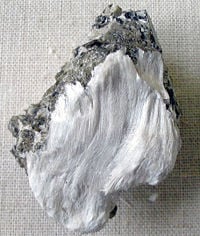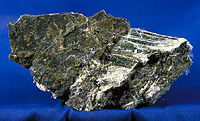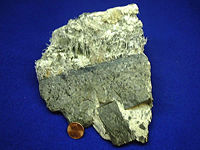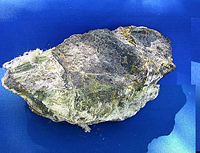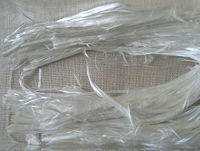Asbestos
Asbestos (a misapplication of Latin: asbestos "quicklime" from Greek ἄσβεστος: a, "not" and sbestos, "extinguishable") describes any of a group of minerals that can be fibrous, many of which are metamorphic and are hydrous magnesium silicates. These minerals, together with their occurrences, uses, and associated hazards, have been discussed in detail by Guthrie and Mossman (1993).
The name is derived for its historical use in lamp wicks; the resistance of asbestos to fire has long been exploited for a variety of purposes. Asbestos was used in fabrics such as Egyptian burial cloths and Charlemagne's tablecloth (which according to legend, he threw in a fire to clean). Asbestos occurs naturally in many forms (see below); it is mined from metamorphic rocks.
When asbestos is used for its resistance to fire or heat, the fibers are often mixed with cement or woven into fabric or mats. Asbestos is used in brake shoes and gaskets for its heat resistance, and in the past was used on electric oven and hotplate wiring for its electrical insulation at elevated temperature, and in buildings for its flame-retardant and insulating properties, tensile strength, flexibility, and resistance to chemicals. The inhalation of some kinds of asbestos fibers, however, can cause a number of serious illnesses, including cancer. Many uses of asbestos are banned in many countries.
Types of asbestos and associated fibres
- "White" asbestos
- Chrysotile, CAS No. 12001-29-5, is obtained from serpentine rocks. Chrysotile is the type most often used industrially. There is evidence that this type of asbestos is harmful, although not perhaps as harmful as other forms (refer to UK Health & Safety Commission report Asbestos: Effects on health of exposure to asbestos, 1985). One formula given for Chrysotile is Mg3(Si2O5)(OH)4.
- "Brown" asbestos
- Amosite, CAS No. 12172-73-5, is a trade name for the amphibole's belonging to the Cummingtonite - Grunerite solid solution series, commonly from Africa, named as an acronym from Asbestos Mines of South Africa. One formula given for Amosite is Fe7Si8O22(OH)2. This type of asbestos is highly biohazardous.
- "Blue" asbestos
- Riebeckite, CAS No. 12001-28-4, also known under the variety name of Crocidolite, is an amphibole from Africa and Australia. It is the fibrous form of the amphibole riebeckite. Blue asbestos is commonly thought of as the most dangerous type of asbestos (see above and below). One formula given for Crocidolite is Na2Fe2+3Fe3+2Si8O22(OH)2. This type of asbestos is highly biohazardous.
Notes: chrysotile commonly occurs as soft friable fibers. Asbestiform amphibole may also occur as soft friable fibers but some varieties such as amosite are commonly straighter. All forms of asbestos are fibrillar in that they are composed of fibers with widths less than 1 micrometer that occur in bundles and have very long lengths. Amphiboles most commonly occur in nature in a safer nonfibrous form. Asbestos with particularly fine fibers is also referred to as "amianthus".
- Other asbestos
- Other regulated asbestos minerals, such as tremolite asbestos, CAS No. 77536-68-6, Ca2Mg5Si8O22(OH)2; actinolite asbestos (or smaragdite), CAS No. 77536-66-4, Ca2(Mg, Fe)5Si8O22(OH)2; and anthophyllite asbestos, CAS No. 77536-67-5, (Mg, Fe)7Si8O22(OH)2; are less commonly used industrially but can still be found in a variety of construction materials and insulation materials and have been reported in the past to occur in a few consumer products. Other natural and not currently regulated asbestos minerals, such as richterite, Na(CaNa)(Mg,Fe++)5[Si8O22](OH)2, and winchite, [ ](CaNa)Mg4(Al,Fe3+)Si8O22(OH)2, maybe found as a contaminate in products such as the vermiculite containing Zonolite insulation manufactured by W.R. Grace and Company. These forms of asbestos are no less harmful than chrysotile, amosite, or crocidolite.
In 1989 the United States Environmental Protection Agency (EPA) passed the Asbestos Ban and Phase Out Rule which was subsequently overturned in the case of Corrosion Proof Fittings v. U.S. Environmental Protection Agency, 1991. This ruling leaves many consumer product that can still legally contain trace amounts of asbestos. For a clarification of products which legally contain asbestos visit the EPA's clarification statement.[1] Depending on the type of Asbestos, the cancer can be worse. It also depends on the amount inhaled. This is a welding occupational hazard.
Uses
Historic usage
Items made of asbestos were held in so great an esteem as to be of equal value with gold; none but emperors and kings had napkins made of it. Supposedly, Charlemagne had a tablecloth made of asbestos. Cleaning an asbestos cloth was simple- it was simply thrown into a fire. Some antiquaries have believed that ancients made shrouds of asbestos, wherein they burnt the bodies of their kings, in order to preserve only their ashes, and prevent their being mixed with those of wood, or other combustible materials commonly used in building funeral pyres.[2]
Others assert that the ancients used asbestos to make perpetual wicks for sepulchral lamps. In more recent centuries, asbestos was indeed used for this purpose. Although asbestos causes skin to itch upon contact, ancient literature indicates that it was prescribed for diseases of the skin, and particularly for the itch. It is possible that they used the term asbestos for alumen plumosum, because the two terms have often been confused throughout history.[2]
Asbestos linings were once used in automobile brake pads and shoes. Since the mid-1990s, a majority of brake linings, new or replacement, have been manufactured with Kevlar linings (the same material used in bulletproof vests).
Kent, the first filtered cigarette on the market, used crocidolite asbestos in its "Micronite" filter from 1952 to 1956.[3]
Modern usage
Serpentine group
Chrysotile is the form of asbestos from the serpentine group that has been used commercially.
In the United States, chrysotile has been the most commonly used type of asbestos. Chrysotile is often present in a wide variety of materials, including but not limited to:
- sheetrock taping
- mud and texture coats
- vinyl floor tiles, sheeting, adhesives and ceiling tiles
- plasters and stuccos
- roofing tars, felts, siding, and shingles
- "transite" panels, siding, countertops, and pipes
- acoustical ceilings
- fireproofing
- putty
- caulk
- gaskets
- brake pads and shoes
- clutch plates
- stage curtains
- fire blankets
- interior fire doors
Amphibole group
Amosite and crocidolite were used in many products until the early 1980s. The use of all types of asbestos in the amphibole group was banned in the mid-1980s. These products were mainly:
- Low density insulation board and ceiling tiles
- asbestos-cement sheets and pipes for construction, casing for water and electrical/telecommunication services
- thermal and chemical insulation (i.e., fire rated doors, limpet spray, lagging and gaskets)
Asbestos as a contaminant
Low levels of asbestos are in the air we breathe and some of the water we drink, including water from natural sources.[4] Studies have shown that members of the general (nonoccupationally exposed) population have tens of thousands to hundreds of thousands of asbestos fibers in each gram of dry lung tissue, which translates into millions of fibers and tens of thousands of asbestos bodies in every person's lungs.[5]
The EPA has proposed a concentration limit of 7 million fibers per liter of drinking water for long fibers (lengths greater than or equal to 5 µm). OSHA (Occupational Safety and Health Administration) has set limits of 100,000 fibers with lengths greater than or equal to 5 µm per cubic meter of workplace air for 8-hour shifts and 40-hour work weeks.[6]
Most respirable asbestos fibers are invisible to the unaided human eye because their size is about 3.0-20.0 µm in length and can be as thin as 0.01 µm. Human hair ranges in size from 17 to 181 µm in width.[7] Fibers ultimately form because when these minerals originally cooled and crystallized, they formed by the polymeric molecules lining up parallel with each other and forming oriented crystal lattices. These crystals thus have three cleavage planes, just as other minerals and gemstones have. But in their case, there are two cleavage planes that are much weaker than the third direction. When sufficient force is applied, they tend to break along their weakest directions, resulting in a linear fragmentation pattern and hence a fibrous form. This fracture process can keep occurring and one larger asbestos fiber can ultimately become the source of hundreds of much thinner and smaller fibers.
As asbestos fibers get smaller and lighter, they more easily become airborne and human respiratory exposures can result. Fibers will eventually settle but may be re-suspended by air currents or other movement.
Friability of an asbestos containing product means that it is so soft and weak in structure that it can be broken with simple finger crushing pressure. Friable materials are of the most initial concern due to their ease of damage. The forces or conditions of usage that come into intimate contact with most non-friable asbestos containing materials are substantially higher than finger pressure. Non-friable asbestos products can release substantial quantities of asbestos fibers into their environments as well.Template:Citationneeded
Diseases caused by asbestos
As early as 1898 the Chief Inspector of Factories of the United Kingdom reported to Parliament in his Annual Report about the "evil effects of asbestos dust". He reported the "sharp, glass like nature of the particles" when allowed to remain in the air in any quantity, "have been found to be injurious, as might have been expected" (Report of the Select Committee 1994). In 1906 a British Parliamentary Commission confirmed the first cases of asbestos deaths in factories in Britain and recommended better ventilation and other safety measures. In 1918 a US insurance company produced a study showing premature deaths in the asbestos industry in the United States. In 1926 the Massachusetts Industrial Accidents Board processed the first successful compensation claim by a sick asbestos worker.Template:Citationneeded Many American injuries from asbestos exposure came from shipbuilders working during World War II.[8]
The problem with asbestos arises when the fibers become airborne and are inhaled. Because of the size of the fibers, the lungs cannot expel them. [Casarrett & Doull's Toxicology (2001), pp 520-522]
Diseases caused by asbestos include[9][10]:
- Asbestosis – A lung disease first found in naval shipyard workers, asbestosis is a scarring of the lung tissue from an acid produced by the body's attempt to dissolve the fibers.[11] The scarring may eventually become so severe that the lungs can no longer function. The latency period (the time it takes for the disease to develop) is often 10-20 years.Template:Citationneeded
- Mesothelioma – A cancer of the mesothelial lining of the lungs and the chest cavity, the peritoneum (abdominal cavity) or the pericardium (a sac surrounding the heart). It is believed that mesothelioma is caused by generation of reactive oxygen species (ROS) by the asbestos fibers. There is also some evidence to suggest that simian virus 40 (SV40) works together with asbestos in the development of malignant mesothelioma. Asbestos exposure is linked to at least 50% of patients developing malignant mesothelioma. Malignant mesothelioma has a peak incidence 35-45 years after asbestos exposure. Median survival for patients with malignant mesothelioma is 11 months. Asbestos has a synergistic effect with tobacco smoking in the causation of pleural mesothelioma.[12]
- Cancer – Lung cancer has been linked to asbestos. Asbestos exposure alone can cause lung cancer, but asbestos exposure and tobacco smoking has a synergistic effect, greatly increasing the chances of contracting lung cancer.[13] Cancer of the larynx has been linked to asbestos. Some studies suggest that asbestos exposure is linked to a slightly increased risk of stomach, pharyngeal, and colorectal cancer.[14]
EWG Action Fund estimates that in the United States, about 9,900 people die each year of asbestos-related diseases, such as mesothelioma, asbestosis, lung cancer, and gastrointestinal cancer.[15]
- asbestos warts – caused when the sharp fibres lodge in the skin and are overgrown causing benign callus-like growths.
- pleural plaques – discrete fibrous or partially calcified thickened area which can be seen on X-rays of individuals exposed to asbestos. They do not become malignant or cause other lung impairment.
- diffuse pleural thickening – similar to above and can sometimes be associated with asbestosis. Usually no symptoms shown but if extensive can cause lung impairment.
Litigation
Asbestos litigation is the longest, most expensive mass tort in U.S. history, involving more than 6,000 defendants and 600,000 claimants.[16] Current trends indicate that the rate at which people are diagnosed with the disease will likely increase through the next decade. Analysts have estimated that the total costs of asbestos litigation in the USA alone will eventually reach $200 billion. Due to the prevalence of asbestos, it is normally part of the scope of a Phase I Environmental Site Assessment to inspect for potential asbestos in a building which is being sold.
The volume of the asbestos liability has alarmed the manufacturers and insurance industry. The amounts and method of allocating compensation have been the source of many court cases, and government attempts at resolution of existing and future cases.
Removal of asbestos
Many buildings contain asbestos, which was used in spray-applied flame retardant, thermal system insulation, and in a variety of other materials. Asbestos was sometimes "flocked" above false ceilings, inside technical ducts, and in many other small spaces where firefighters would have difficulty gaining access. Structural components like asbestos panels were also used. In residences, asbestos was often a component of a type of flocked acoustic ceiling called "popcorn ceiling", until its production was banned in the U.S. in 1978. However, the ban allowed installers to use up remaining stocks, so houses built as late as 1986 could still have asbestos in their acoustic ceilings. The only way to be sure is to remove a sample and have it tested by a competent laboratory.
Depending on how and where asbestos was applied, it might not pose any risk to most users of the building. If the fibers cannot become dislodged, they cannot be inhaled, and thus the asbestos poses no risk.
However, some methods of applying asbestos, particularly flocking, allow asbestos fibers to gradually drop off into the air. Asbestos poses hazards to maintenance personnel who have to drill holes in walls for installation of cables or pipes.
Even if the workers are protected, such maintenance operation may release fibers into the air, which may be inhaled by others. Interventions in areas where asbestos is present often have to follow stringent procedures. If removal is to be performed when users are still present in the building, it is usually necessary to relocate some users temporarily. Typically, the part of the building from which asbestos is being removed has to be sealed off in order to prevent contamination of the other areas.
If the building is closed to normal users, it may be necessary to seal it off from outside atmosphere so that no accessible air is contaminated. Examples of asbestos removal enterprises include the Jussieu Campus (begun circa 1996 and still going on as of 2005) and the Tour Montparnasse (in 2005, projected duration was 3 years if the tower was emptied of its users, and 10 years if it was not).
An asbestos-containing building that is to be torn down may have to be sealed, and to have its asbestos safely removed before ordinary demolition can be performed. The asbestos removal may take longer and cost more than the actual demolition. For example, the former seat of parliament of East Germany, the Palast der Republik was stripped of most of its asbestos between 1998 and 2001, before it was finally demolished starting in 2006. The demolition process alone is expected to cost between 20 and 60 million Euros.
Critics of safety regulations
Asbestos regulation critics include Junkscience.com author and Fox News columnist Steve Milloy and the asbestos industry.[17] They sometimes argue that the ban does more harm than good and that replacements to asbestos are inferior. An example is the suggestion that the shuttle Challenger exploded because the maker of O-ring putty was pressured by the EPA into ceasing production of asbestos-laden putty. However, scientists point out that the putty used in Challenger's final flight did contain asbestos, and failures in the putty were not responsible for the failure of the O-ring that led to loss of the shuttle.[18][19]
Scott Bass suggests that the World Trade Center towers could still be standing or at least would have stood for longer had a 1971 ban not stopped the completion of the asbestos coating above the 64th floor.[20] This was not mentioned in the National Institute of Standards and Technology's report on the Towers' collapse. Insulation that replaced asbestos is believed to have equivalent fire resistance, and any sort of sprayed-on insulation, including asbestos-based material, would have been removed in large areas by the impact of the planes and subsequent explosion.[21][22][23]
Substitutes for asbestos in construction
Many companies that produced asbestos-cement products that were reinforced with asbestos fibres have developed products incorporating organic fibres. One such product was known as Eternit and another Everite now use Nutec fibres which consist of organic fibres, portland cement and silica.
See also a report by the Australian government, Hazardous Substances-Chrysotile Asbestos: Technical Assessment of Alternatives.
See also
- Ambler, PA
- Asbestine
- Asbestos and the law
- Asbestosis
- Asbestos, Quebec
- Brominated flame-retardant
- Eternit
- Fireproofing
- List of minerals
- Mesothelioma
- Vermiculite
- Wittenoom, former asbestos mining town
Footnotes
- ↑ EPA clarification statement on asbestos (PDF format.
- ↑ 2.0 2.1 History of science This article incorporates content from the 1728 Cyclopaedia, a publication in the public domain.
- ↑ Cancer Research 55, 1 June 1995
- ↑ Centre for disease control article on asbestos
- ↑ Medscape article on asbestos
- ↑ Agency for toxic substances and disease registry article on asbestos
- ↑ Physics factbook on asbestos
- ↑ American Academy of Actuaries Overview ofAsbestos Issues and Trends (PDF)
- ↑ Environmental Protection Agency article on asbestos
- ↑ Questions and answers regarding asbestos from Lakeside press
- ↑ Asbestosis article from the National Institute of Medicine
- ↑ E-medicine article on malignant mesothelioma
- ↑ Medicinenet article on asbestos related disorders
- ↑ National Academy of Science on links between asbestos and different types of cancer
- ↑ Asbestos and cancer
- ↑ American Bar Association article on asbestos litigation
- ↑ Multinational Monitor article on Corporate junk science, retrieved December 16th, 2006
- ↑ MSNBC article on myths of the Challenger disaster, retrieved December 16th, 2006
- ↑ Asbestos and the Challenger disaster, retrieved December 16th, 2006
- ↑ Fox News - Asbestos could have saved the World Trade Center, retrieved December 16th, 2006
- ↑ Asbestos and the WTC collapse, retrieved December 16th, 2006
- ↑ Center for Fire Research PDF, retrieved December 16th, 2006
- ↑ Why Did the World Trade Center Collapse? Science, Engineering, and Speculation, retrieved December 16th, 2006
ReferencesISBN links support NWE through referral fees
- George B. Guthrie and Brooke T. Mossman, editors, Health Effects of Mineral Dusts, Mineralogical Society of America Reviews in Mineralogy v. 28, 584 pages (1993) ISBN 0-939950-33-2
Regulatory and Government Links
- U.S. EPA Asbestos Home Page
- Directory of Accredited Laboratories - Asbestos Fiber Analysis (TEM Test Method)
- Congressional Research Service (CRS) Reports regarding asbestos
- Health History Source: Article by the SafetyLine Institute - WorkSafe - Western Australian state government
- Asbestos and Occupational Health in the World
- British Government Health and Safety Executive (HSE)
Mineral & Mining links
- Parachrysotile (asbestos) at the webmineral.com Mineral Database
- Univ. of Minn.: Asbestos
- Asbestos Newspaper Articles Archive
- Asbestos in the World
- White Gold Pioneers: Asbestos Mining — The origins of asbestos mining, illustrated with many early photographs
Health & The Environment
- About Your House — General Series — Asbestos
- Hazards.org
- Case Studies in Environmental Medicine: Asbestos Toxicity
- The Miracle Mineral Fiber - Asbestos A gruesome industrial crime story by: Dr. Noel Kerin
- CBC Digital Archives - Asbestos: Magic mineral or deadly dust?
- An article on the health impact of asbestos from Liverpool's 'Nerve' magazine
- The Wittenoom Tragedy, Asbestos Diseases Society of Australia.
- Health and Safety - Asbestosis (TUC Resources, UK)
- UK asbestos news Thames Laboratories
- "According to Plan: The beauty and functionality of asbestos sidewalls" - A 1952 Asbestos Commercial featuring footage of scientists handling asbestos in several forms without gloves
- International Asbestos Victims Memorial
- About Asbestos European Agency for Safety and Health at Work (OSHA)
- Asbestos contamination near abandoned mine
Credits
New World Encyclopedia writers and editors rewrote and completed the Wikipedia article in accordance with New World Encyclopedia standards. This article abides by terms of the Creative Commons CC-by-sa 3.0 License (CC-by-sa), which may be used and disseminated with proper attribution. Credit is due under the terms of this license that can reference both the New World Encyclopedia contributors and the selfless volunteer contributors of the Wikimedia Foundation. To cite this article click here for a list of acceptable citing formats.The history of earlier contributions by wikipedians is accessible to researchers here:
The history of this article since it was imported to New World Encyclopedia:
Note: Some restrictions may apply to use of individual images which are separately licensed.
